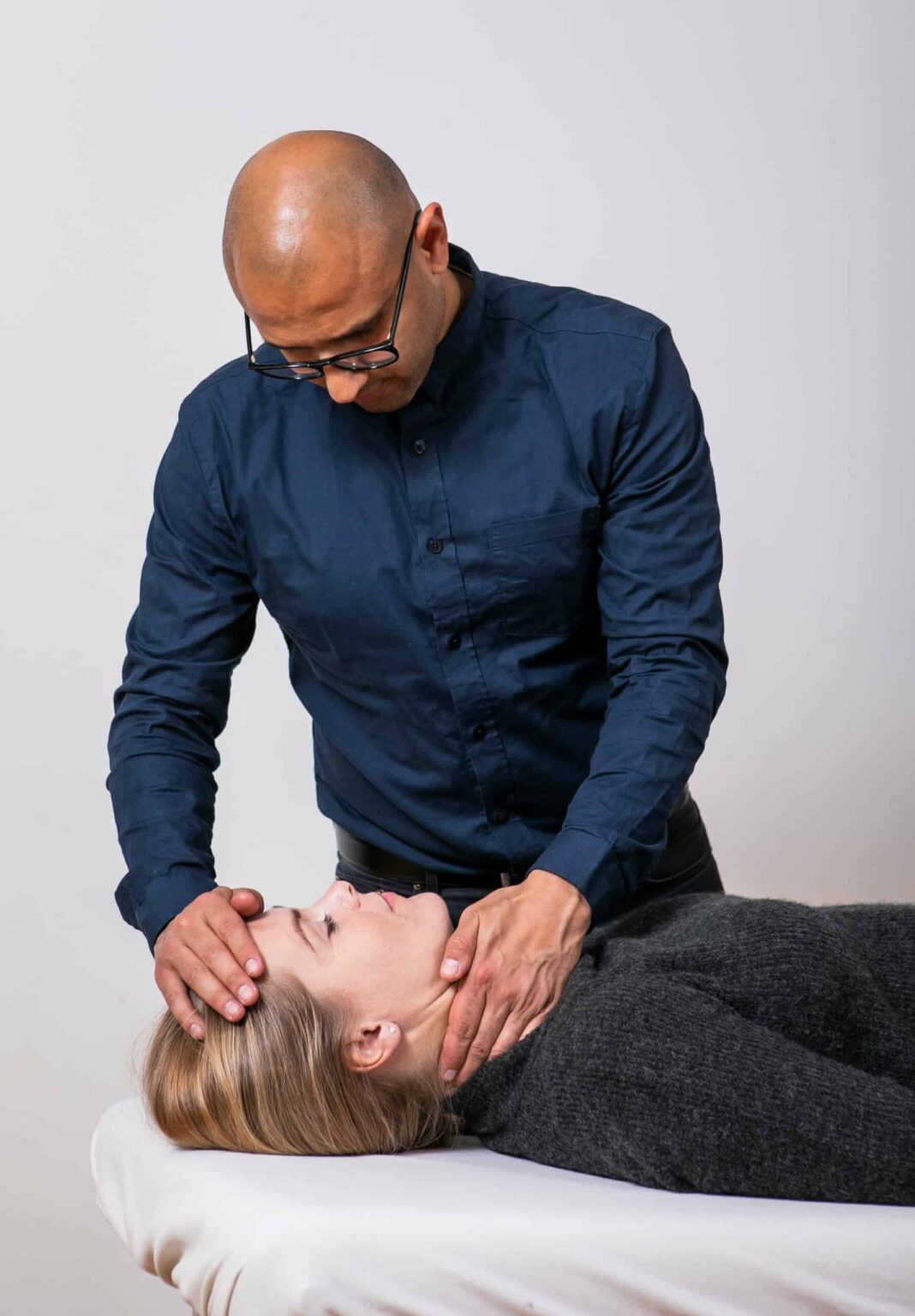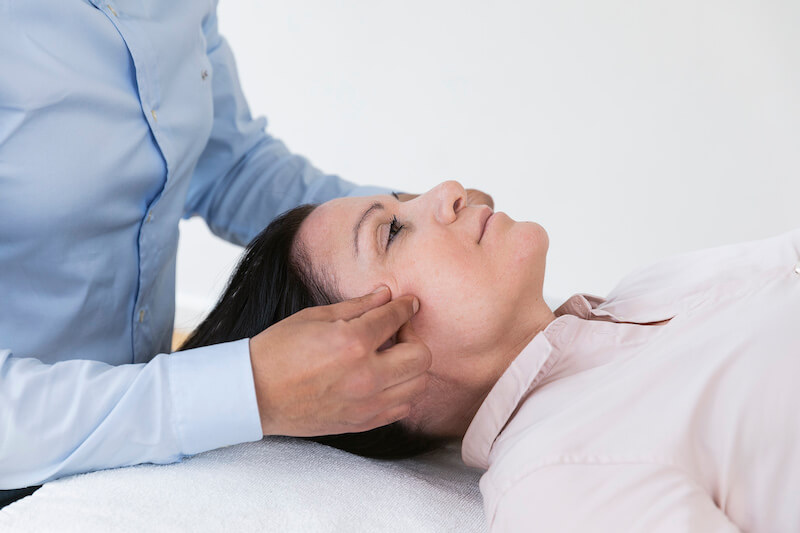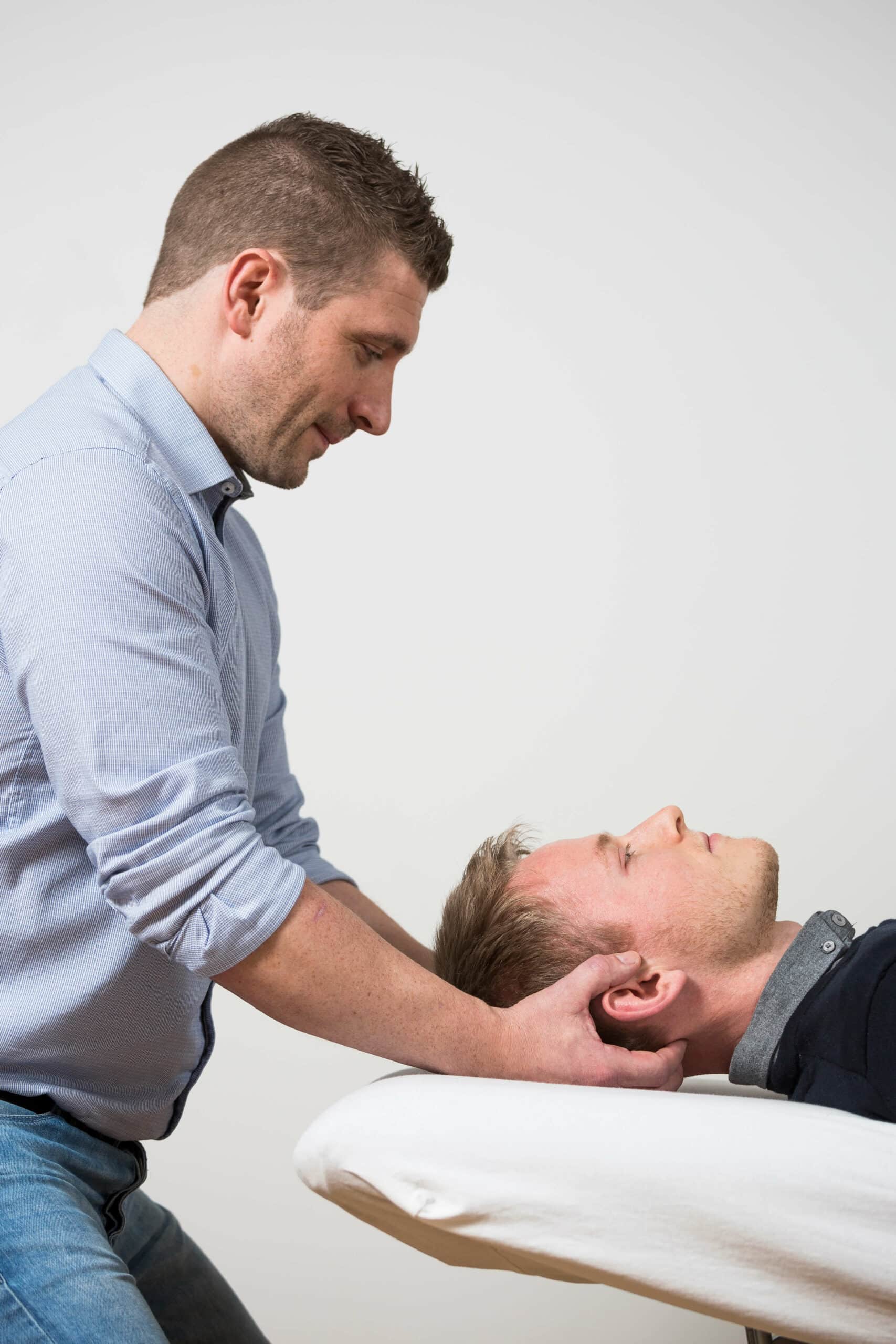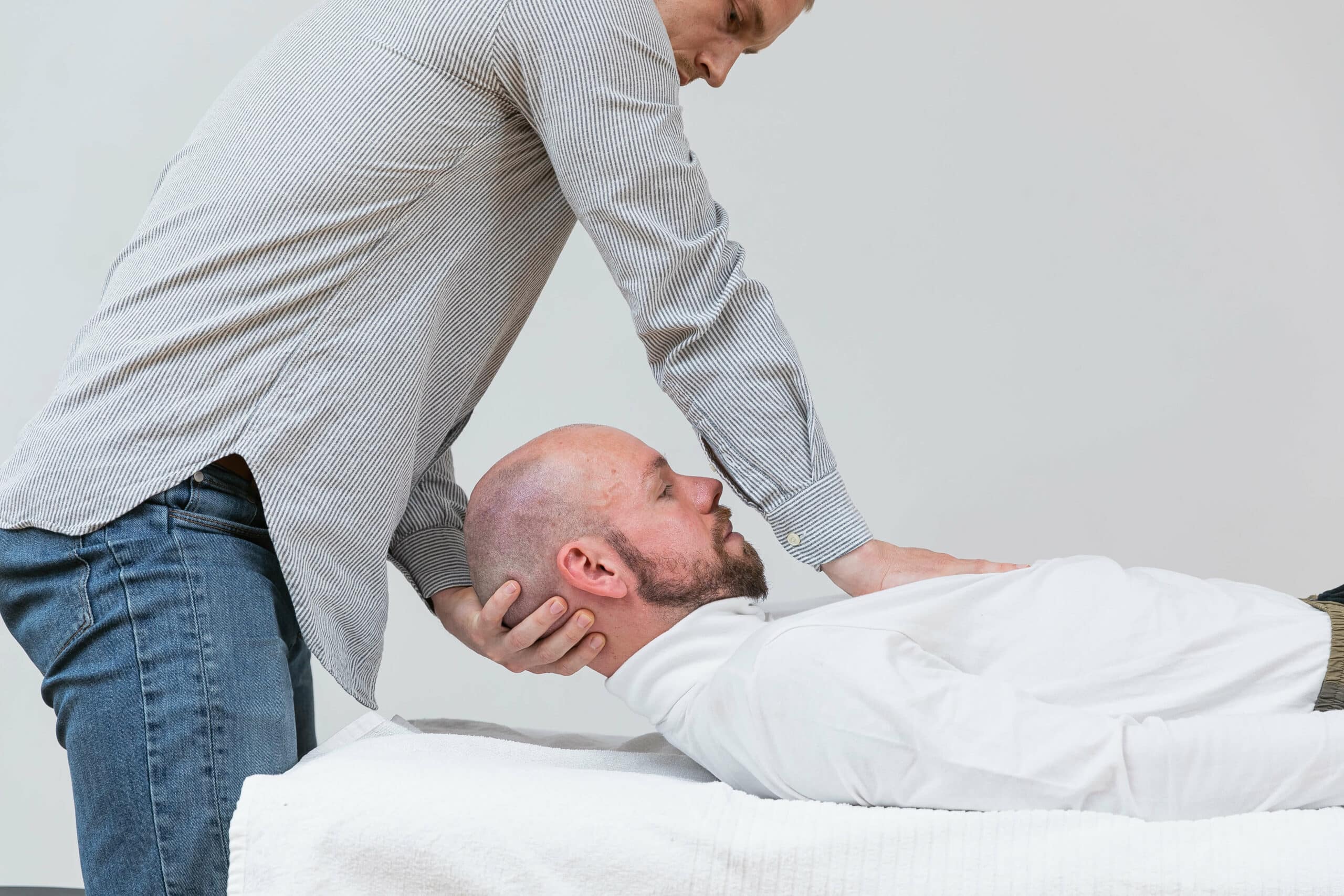We treat
Neck pain
Learn more about neck pain
Neck pain
Neck pain occurs in 30-50% of the adult population during the course of a year, and neck pain is one of the most frequent causes of sick leave.
It is estimated that 3-7% of the population sees a doctor with neck pain as their main problem during the course of a year.
Jump to section [Vis]
Symptoms and consequences of pain in the neck
- Neck ache
- Locking of the neck
- Neck stiffness
- Sleeping and tingling fingers
- Pain radiating into the arm
- Throat problems
- Disc herniation in the neck
- Dizziness
- Osteoarthritis in the neck
- Headache
- Migraine
- Radiating pain in the arms
About neck pain and the vagus nerve (stomach problems)
The vagus nerve, which is the tenth cranial nerve, originates from the brain and the upper cervical vertebrae (C0-C2) and is the longest nerve in the human body. The nerve has many functions, but plays an important role in digestion and intestinal peristalsis. The nerve’s primary function in this regard is sensory, i.e. the nerve registers the state of the digestive system and sends information to the brain. This therefore means that digestive and stomach problems can cause increased stimuli/pain in the upper neck.

Neck pain and dizziness
Dizziness often occurs in people who suffer from neck pain, and the causes can be many. A common cause is locking in the neck, which can lead to pinching or pressure on a blood vessel leading to the brain.
The relevant blood vessels are the vertebral artery, which enters at the transverse process from the uppermost to the sixth cervical vertebra, and the carotid artery, which is located in the neck.
Chronic neck pain can also stem from partial occlusion of the vertebral artery (vertebrobasilar insufficiency).
Neck pain that causes nausea
When neck pain becomes a regular part of a client’s daily life, they often report nausea. Nausea can be caused by neck pain and tension affecting the vagus nerve. Long-term neck pain can therefore affect various parts of the digestive system and cause nausea. Other neck-related issues that can cause nausea include cervicogenic dizziness, which is caused by neck locking or other effects on the upper neck joints.
Neck pain and pain radiating into the arm
Neck stiffness (locking in the neck), herniated disc or protrusion, spinal stenosis, etc. can all cause symptoms in the arm, such as pain or numbness/tingling in the fingers.
Nerves that run from the neck form the brachial plexus, which includes the ulnar, radial, median, and musculocutaneous nerves.
These nerves control the muscles in the arms and send small branches out into the skin that register sensation, position, etc. Therefore, pressure on one or more of these nerves can cause pain in the arm and/or numbness and tingling in the fingers.
Neck pain and headaches
Neck pain can often trigger so-called cervicogenic headaches or tension headaches. When the neck is locked or tense, it can cause the nerves that originate in the cervical vertebrae to radiate up to the head. In addition, tension in the neck, through the muscles and connective tissue, can cause tension headaches. Symptoms of cervicogenic headaches include headache, nausea, tense muscles and more.
In this video, we show you an exercise that helps strengthen your neck and improve flexibility using a resistance band

Neck pain in children
There is an increasing trend of children and adolescents seeking medical attention or treatment for so-called mobile or iPad neck. This condition is caused by the prolonged positions used when using a mobile or tablet, which are not appropriate for the muscles, connective tissue and joints in the neck. Neck pain caused by using a mobile phone will often lead to poor posture, which also contributes to further problems in the neck and other discomforts in the body, such as back pain.
Connection between the pelvis and neck pain
An important connection between the pelvis and the neck is the dura mater. This membrane originates from several places in the skull and extends down towards the pelvic bone and tailbone. Along the way, the dura mater attaches to the upper neck muscles and the inside of all vertebrae.
Neck pain at work
Today, the majority of the population has sedentary work in an office or similar. This is seen to have a major impact on the development of neck pain. Sedentary work will negatively affect muscles, connective tissue, circulation and organ systems.
We find that sedentary work often contributes to the development of tension in and around the neck, cervicogenic headaches, muscular tightness of the neck muscles, and more.
Neck pain and the meninges
The brain and spinal cord are covered by three strong membranes, the dura mater, the arachnoid mater and the pia mater. These membranes have the function of protecting the nervous system and of delimiting the fluid, the cerebrospinal fluid, that is located between the membranes and the brain/spinal cord. These membranes have contact with the upper neck muscles (suboccipital muscles) and all vertebrae in the back including the cervical vertebrae. Therefore, impacts on the membranes such as whiplash, falling on the tailbone, lumbago (back pain) or other disorders in the spinal canal can have an impact on neck pain. We call this part the craniosacral system.

The body as a whole in relation to neck pain
Osteopathy looks at the body from a holistic perspective and examines all the different systems: joints, muscles, nervous system, organ system, blood system, lymphatic system and cranial system. The aim is to identify the underlying cause of the neck pain.
It is essential that these systems work together to achieve effective healing of neck pain. Good function of the organ system is essential for the body to relieve neck pain. The cranial system regulates the autonomic nervous system, which, among other things, controls the functions of the organs, the nervous system, the lymphatic system and blood circulation. The nervous system also plays an important role in regulating hormones to the organs and in controlling the blood and lymph circulation in the injured area, so that damaged tissue is supplied with oxygen and nutrients.
Head and neck pain can originate from elsewhere in the body
The osteopathic principle is that imbalances in one part of the body can affect other areas, and the principle emphasizes how a disturbance in one part of the body can resonate throughout the entire system.
Connective tissue lines, which are chains of connective tissue, extend from the legs, abdomen, and chest and attach at the base of the neck. If these chains become tense or unbalanced, it can lead to neck pain.
From the skull and neck arise several nerves that are of great importance for the function of the body. These nerves supply, among other things, the organ system, jaw and mouth, eyes, ears, pleura and membrane around the internal organs. The nerves consist of activation and sensory nerves, which means that they both promote the function of the areas they supply, but that they also register how the area is feeling.
Therefore, problems elsewhere in the body can cause pain in the neck.
Neck pain and the phrenic nerve
The phrenic nerve (n. phrenicus) originates from the second to fourth cervical vertebrae (C2-C4). The nerve’s function is motor to supply the diaphragm with nerve impulses, which is why it ensures that we can breathe automatically. However, the nerve’s greatest function is sensory, where it registers the condition of the peritoneum, the pericardium and the pleura. If there is irritation, inflammation or a problem in one of these areas, nerve signals will be referred to C2-C4 in the neck. Thus, problems in the chest, respiratory muscles or digestive organs can cause pain in the neck.

Osteopathic approach to neck and head pain
- To find and optimize the areas that the neck compensates for, so that the pain/irritation has time to heal.
- To optimize blood circulation in the area. Treatment of the heart, lungs, chest, respiratory muscles, liver, intestines and left kidney is important.
- To ensure optimal function and mobility around the upper cervical vertebrae and skull as well as the upper thoracic vertebrae, as this area is crucial for blood flow and the autonomic nervous system.
- To optimize the function and mobility of the cervical vertebra itself, corresponding to the pain in the neck.
- To optimize the immune system, diet and lifestyle, and to treat the adrenal glands.
Is osteopathy effective for chronic neck pain
Franke and Fryer conducted a systematic review and meta-analysis of osteopathic manipulation treatment for chronic neck pain. They found several studies that showed strong evidence that osteopathic manipulation treatment was effective for chronic neck pain. Schwerla F. et al. also found that osteopathic manipulation treatment was possibly effective for chronic neck pain.
The body can heal itself, including neck pain
Under the right conditions, the body can heal itself. If all systems function together and individually, excessive mechanical stress on the neck, inadequate transport of oxygen and nutrients to and from the area, and inadequate nerve supply can be avoided. This way, the body will have optimal conditions for healing.
Osteopathy stimulates, regulates and restores all of these systems.

What can you do yourself to relieve neck pain?
Neck pain affects a large portion of the population over the course of a year, but it is not always necessary to seek out an expert in neck pain treatment immediately. There are various things you can try yourself first, such as:
- Change your working position frequently – alternate between sitting and standing at the workplace.
- Do exercises for the neck 10-15 minutes a day
- Make sure the rib cage is mobile – 30-40% of neck mobility depends on the thoracic spine
- Strengthen your shoulders and neck muscles
Causes of neck pain
- Stomach problems via the vagus nerve
- Heart, lung, and organ problems
- Locking of the neck
- Trauma to the neck such as whiplash
- Tension of muscles and connective tissue from the chest
- Impact on the meninges, i.e. back problems, tailbone problems, etc.
- Disc herniation in the neck
- Stenosis in the neck
- Osteoarthritis in the neck
- Neck sprain
- Osteoporosis collapse in the neck
Acute neck sprain
A stiff neck is a common condition that causes pain and stiffness in the neck area. It can occur due to various factors such as poor posture, overexertion, stress, or incorrect sleeping positions.
Typically, people with neck stiffness experience a sudden sharp pain or a gradual increase in tension and discomfort.
It can limit the range of motion of the head, and in some cases cause headaches and pain that radiates down the shoulders and arms. Treatment usually includes rest, the use of hot or cold compresses, massage, osteopathy, and exercises to increase flexibility and strength in the neck.
In some cases, painkillers or anti-inflammatory drugs may also be recommended.
Preventing neck strain focuses on maintaining good posture, avoiding excessive strain, and practicing ergonomic techniques during work and daily activities.

Often related injuries

Hypermobility in babies and children

Muscle tension or imbalances in babies and children

Neck strain

Pinched nerve in the neck

Disc herniation in the neck

